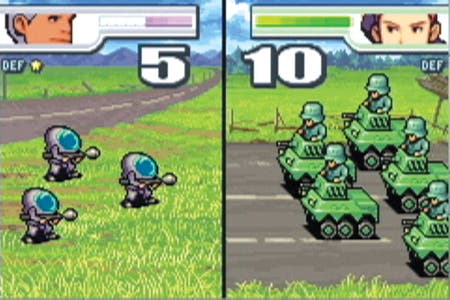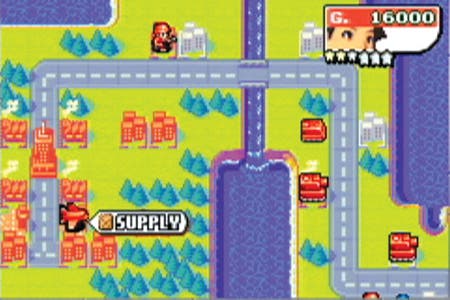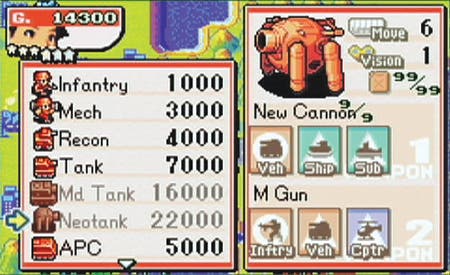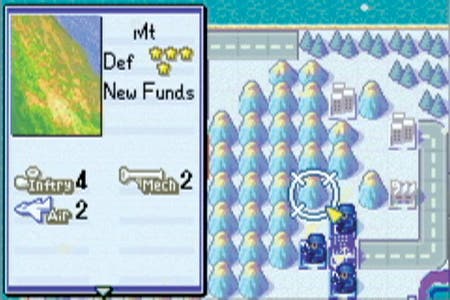Advance Wars 2: Black Hole Rising
There's a war coming.
Yeah yeah, we know it's been out for a few weeks now (or a few months if you picked it up on import), but it’s always worth reviewing the really good ones that got away, eh? Anyone who played the 2001 original will remember it was (and is) among the best handheld games ever released, somehow managing to make turn-based strategy gaming accessible to the most hardened opponent of the oft-impenetrable genre.
All rise

One of the main reasons this has been left on the back burner for so long is that it was immediately apparent that this follow-up adds relatively little to the original. Nintendo's business model on its handheld marvel doesn't really allow for expansion packs, but that's effectively what Black Hole Rising is. To the untrained eye, you'd assume this was the original; it uses the exact same graphics, the same combat mechanics and even basically the same music, but for the money no object crowd, you do get a few new features to sample; a new unit (the powerful Neo tank), dozens of new missions, and the all-important ability to play from the perspective of the COs that were your enemy in the original, uniting against the Black Hole forces.
Again, the object is simply to defeat the enemy. To kick off with, you're in charge of co-ordinating a small but perfectly formed military collective by the name of Orange Star to victory via a simple overhead tactical map that forms the basis of the game. Taking it in turns, players get to plan their moves, build units, and ultimately attack the opposition, at which point the game switches to a more pleasing 3D representation of the battle with each side facing one another. Each unit starts of with 10 hit points (HP) and is comprised of various defensive and attacking capabilities, and how much HP you hack off your opponent is down to who strikes the first blow and thereafter relies on a simple paper scissors stone equation. But however straightforward it might seem, it's a deceptively cunning and balanced system that forms the heart of an incredibly addictive game.
I am the Grandmaster

Later on you get to command Blue Moon, Yellow Comet and Green Earth in a series of far more challenging campaigns with bigger maps requiring greater strategic depth. Once again there's a comprehensive selection of weaponry at your disposal; two infantry types, nine ground units (including the game's sole new addition - the costly spider-esque Neo tank - easily the most powerful ground unit), four air units and four sea-based units. Naturally there's a higher price attached to the more deadly units, and it's always a perilous balancing act trying to judge what the best strategy is. In our experience, most battles are so finely poised that you'll fail or scrape through by the skin of your teeth, but it all conspires gracefully so you can't resist having one more go. Within minutes you'll not care one iota that this game is so essentially old school and the graphics are so basic. It's intensely addictive and almost chess-like in its depth. Really.
Further to the basic mix, each army is comprised of three distinct characters with their own strengths and weaknesses, and two super powers that can be unleashed once they've charged up enough during battle - giving the player a brief advantage on a turn of their choice. For example, some COs may have greater indirect attacking abilities, an impressive aerial arsenal, but have utterly useless ground forces, or might not be able to move all that quickly. A super power might help them improve the amount of spaces they can move, or increase their attacking power and so on.
The key thing to learn is that cost is everything, and without cash you're as good as dead as you'll be unable to build up your forces quick enough (or at all). Similarly, without a number of cities or bases under your belt you'll be handicapped, so the key is always to make the most of what each map offers you, and if that means spending a few turns just capturing all the facilities you can, then so be it - if you don't, your enemy almost certainly will, so it's vital.
You're in the army now

Other missions, however, insist that you simply make do with what you've got, denying you any opportunity to amass a fearsome army, while others may task you with defeating the enemy within a limited number of turns. It's never as straightforward as you think, and it's this consistent variety that has you hooked from the off.
Adding an extra layer of strategic depth is the terrain, which provides extra defensive cover for you or your enemy, or shrouds the land in a fog of war. In this situation you can effectively blunder straight into enemy lines, so you'll be forced to experiment with all manner of tactics before you suss out the best approach. Another subtle addition is the new terrain items that spice up certain missions; one might have a volcano to negotiate or a pipeline that's spewing out enemy units that you have to destroy, or missile silos raining death down on your troops that you have to work out how to stop. Although this still isn't anything majorly different from the original, it's so ridiculously addictive, the chances are that some of you won't really care all that much. You'll just be grateful that Intelligent Systems has served up some another strategic masterpiece.
As with the original, the missions start off as little more than a tutorial, but the hand-holding has been largely curtailed this time - so newbies should be aware that they're thrown into the fray a fair bit quicker this time around and it does ramp up in difficulty relatively quickly. Outside of the main campaign mode, there are plenty of other modes to keep you amused long after you've finished trying to get an S rating for each one. You earn a proportionate number of points for each successful mission, which unlock numerous standalone maps in the War Room to which you'll lose even more hours of your life. Add to that a fantastic Versus multiplayer mode for up to four players (on one GBA, or link mode if you each have a copy), and a map editor to create your own if you're really obsessed, and it's undeniably packed to the rafters.
Stuffed to the gills

Taken in total isolation, there's no doubting Advance Wars 2 is a truly fantastic game; you'll lose literally tens of hours of your life without even blinking and Intelligent Systems deserves massive credit for playing to the strengths of the format - something so few handheld developers ever do. There's the potential for an unspeakable amount of gameplay time within - you'll be carrying this one around with you for months, flipping out the GBA for a quick session at every conceivable opportunity, wandering around playing it when you're walking down the street, hardly even noticing the cars swerving around you and the cursing pedestrians. Your partner will disown you, your pets will whimper at the lack of attention, you'll forget to eat.
But - and damn those buts - this is one of those games that should have a warning strapped to its front like a cigarette packet. Deciding whether you should buy it is an altogether trickier prospect. Sure, it's a classic, but it's so obviously a £35 mission pack, and is probably double the price it should have been. Unless you were utterly captivated by the original and spend every day pining for more, or never owned the original, it's hard to justify why you should shell out for it. Re-releasing the same game with a smattering of extras frankly isn't something to be encouraged when there are already so many great titles vying for your attention out there, and the original is doubtlessly available at a knockdown price.








